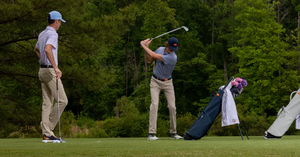How Far Should a 56-Degree Wedge Go?
Becoming an excellent golfer comes down to a number of factors, including the amount you practice, what techniques you employ, and the variety of courses you play. But another huge factor that many golfers miss is the type of clubs you use.
Most golfers play with a standard set of drivers, irons, putters, and wedges. But each of these clubs has its own subset of different types. When it comes to wedges, it's vital you understand what to use for chipping, bunker shots, and pitch shots. Here's everything you need to know about playing with a 56-degree wedge.
What is a 56-Degree Wedge?
Golf is one of the oldest known sports still played around the world. The game stretches back at least as far as the 1400s, when King James II ordered a ban on golf because it was distracting the citizenry from practicing their required military bow and arrow training.
In the 600+ years since, the sport has evolved to a considerable degree. Even when it comes to just clubs, there's an intimidating array of varieties on the market. There are pitch wedges, sand wedges, fairway woods, utility clubs, belly putters, broomstick putters, and so on.
Wedges are generally divided into four types: pitching, gap, lob, and sand wedges. The wedge is the club you reach for when you need to make a short distance, precisely directional shot, especially if that shot needs the ball to bounce up and out. The technical name for a sand wedge is a 56-degree wedge, since that's the number of degrees of loft the club face has.
This club allows for a high bounce, making it perfect for lobbing balls out of sand traps. You should always keep a 56-degree wedge in your golf bag for this exact reason. But a fair warning: 56-degree wedges are commonly the heaviest club in any golfer's bag, so be prepared to break a sweat for this game-saving club.
56-Degree Wedge Distance
As with all clubs, the distance you can expect to achieve with this club varies. Sand wedges can lob balls anywhere from 60 yards on the lower end to 115 yards on the upper end. It depends on whether you're a professional or an amateur, where you're hitting from, and where you want the ball to go.
But generally, once you get used to using your sand wedge, you can expect the ball to be hit anywhere between 80 and 90 yards.
Where Do You Hit a 56-Degree Wedge?
Now that we know what the 56-degree wedge is for and how far it can lob a golf ball, it's time to talk about when to use it. These are the five most common situations in which you should reach for your sand wedge.
Out of the Sand
Every golfer fears hitting the ball into a sand trap or other hazard. But having to venture into the wild unknowns of the course only increases the health benefits of golf, which heavily rely on the exercise of trekking around the course.
That said, you have to get your ball out of there if you want to finish the round. There's a reason the 56-degree wedge is referred to as the sand wedge. It's the ideal club to use to get your ball out of a sand trap. Use a standard chip shot to get the ball aloft without burying your swing in the sand. From there, you can lob it easily out of the sand trap.
Out of the Fairway
56-degree wedges are great for sand traps, but they also work great for shots from the fairway and the rough. If you keep any additional wedge in your golf bag, it should be the 56-degree wedge because of its versatility.
You can employ a standard chip shot or a shorter chip shot to get your ball out of the fairway with your 56-degree wedge. A 54-degree wedge would also come in clutch if your ball is 90 yards out in the fairway. But a normal stock swing with your 56-degree wedge will give you the loft and distance to get yourself off the fairway.
Chipping Out of Thick Rough
You have likely experienced the disappointment of being just a few yards off the green, thinking you can hack the shot close to the hole, and seeing the overshot boll roll into thick rough. What to do then?
Grab your trusty 56-degree wedge for some added loft. Hit the ball lower so you can get out of the rough and back onto the green.
Trying to Get Over a Tree
It's not uncommon to find yourself staring down a hole – with a tree completely blocking your shot. In this instance, you can also use your sand wedge to hit a high shot over the tree. You need to achieve a maximum trajectory level that only the sand wedge can provide.
On the Fringe
If you find yourself on the fringe of the green, you can reach for your sand wedge again. Any time you need to pop your ball into the air and land it anywhere from 60-100 yards on, you can trust this club.
Frequently Asked Questions
How Far Should a Man Hit a 56-Degree Wedge?
The question isn't how far you should hit with your 56-degree wedge but how far you want to hit. Whether you're in the rough, on the fringe of the green, or staring down a tree between you and the hole, a sand wedge can help. But you have to practice to know how to achieve different degrees of loft and distance.
Final Thoughts
For all your golf gear and apparel needs, shop the entire collection at Stitch Golf. We've got you covered for the casual games, the competitive tournaments, and the lazy summer afternoons when you want to kick back at the clubhouse.



